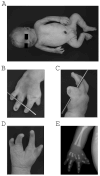Mosaic trisomy 17: variable clinical and cytogenetic presentation - PubMed (original) (raw)
Case Reports
Mosaic trisomy 17: variable clinical and cytogenetic presentation
Robert Daber et al. Am J Med Genet A. 2011 Oct.
Abstract
Mosaic trisomy 17 is rare with only 28 cases reported and the clinical presentation is highly variable. The diagnosis is most commonly made by prenatal karyotype and in most cases is followed by a normal postnatal karyotype on blood lymphocytes.We present two cases of mosaic trisomy 17 diagnosed prenatally,with follow up in multiple tissues at birth. In the first case,trisomy 17 was identified in all amniocytes, and at birth standard results of chromosome analysis in peripheral blood were normal,but mosaic trisomy 17 was identified (50–75%) in skin fibroblasts by genome-wide SNP array analysis. This patient presented with congenital heart disease, asymmetry, intestinal malrotation, and other anomalies and died on day 9 of life. In the second patient amniocentesis after ultrasound finding of tetralogy of Fallot showed mosaic trisomy 17. Postnatally, results of a SNP array were normal in blood, buccal mucosa, and skin. It is possible that the cardiac defect is related to trisomy 17 in key tissues during heart development, although at birth the aneuploidy could not be identified in tissues that are routinely analyzed for diagnosis. These cases add to our understanding of mosaic trisomy 17, highlighting the failure to diagnose this aneuploidy in peripheral blood.
Copyright © 2011 Wiley-Liss, Inc.
Figures
Figure 1
A and B. Patient 1. Note hypertelorism, deep set eyes, micrognathia, and broad forehead.
Figure 2
A. Patient 1 body asymmetry. B, C, D. Findings of split hand on the right and the corresponding radiograph E.
Figure 3
SNP microarray results: SNP array results for case 1 (A and B) showing 75% trisomy 17 in right sided fibroblast (A) and 50% trisomy 17 in left sided fibroblasts (B). Mosaic trisomy 17 could not be detected in fibroblasts from case 2 (C).
Similar articles
- Mosaic trisomy 17 at amniocentesis: Prenatal diagnosis, molecular genetic analysis, and literature review.
Chen CP, Wang LK, Chern SR, Chen YN, Chen SW, Wu PS, Town DD, Pan CW, Yang CW, Wang W. Chen CP, et al. Taiwan J Obstet Gynecol. 2016 Oct;55(5):712-717. doi: 10.1016/j.tjog.2016.07.006. Taiwan J Obstet Gynecol. 2016. PMID: 27751421 Review. - Prenatal diagnosis of mosaicism for double aneuploidy of 47,XXY and trisomy 7 (48,XXY,+7) at amniocentesis in a pregnancy with a favorable outcome.
Chen CP, Tsai HT, Chern SR, Wu PS, Chen SW, Wu FT, Chen YY, Town DD, Chen WL, Lee MS, Wang W. Chen CP, et al. Taiwan J Obstet Gynecol. 2021 May;60(3):543-548. doi: 10.1016/j.tjog.2021.03.029. Taiwan J Obstet Gynecol. 2021. PMID: 33966745 - Cytogenetic discrepancy between uncultured amniocytes and cultured amniocytes in mosaic trisomy 15 at amniocentesis.
Chen CP, Hsu TY, Ko TM, Chern SR, Wu PS, Chen SW, Wu FT, Chen YY, Lee CC, Pan CW, Wang W. Chen CP, et al. Taiwan J Obstet Gynecol. 2020 Sep;59(5):728-735. doi: 10.1016/j.tjog.2020.07.018. Taiwan J Obstet Gynecol. 2020. PMID: 32917326 - Postnatal confirmation of prenatally diagnosed trisomy 16 mosaicism in two phenotypically abnormal liveborns.
Pletcher BA, Sanz MM, Schlessel JS, Kunaporn S, McKenna C, Bialer MG, Alonso ML, Zaslav AL, Brown WT, Ray JH. Pletcher BA, et al. Prenat Diagn. 1994 Oct;14(10):933-40. doi: 10.1002/pd.1970141007. Prenat Diagn. 1994. PMID: 7899268 - Mosaic trisomy 15 at amniocentesis: Prenatal diagnosis, molecular genetic analysis and literature review.
Chen CP, Chern SR, Chen YN, Wu PS, Yang CW, Chen LF, Wang W. Chen CP, et al. Taiwan J Obstet Gynecol. 2015 Aug;54(4):426-31. doi: 10.1016/j.tjog.2015.06.002. Taiwan J Obstet Gynecol. 2015. PMID: 26384064 Review.
Cited by
- Rare case of live born with confirmed mosaic trisomy 17 and review of the literature.
Baltensperger A, Haischer G, Rohena L. Baltensperger A, et al. Clin Case Rep. 2016 Mar 16;4(4):420-4. doi: 10.1002/ccr3.397. eCollection 2016 Apr. Clin Case Rep. 2016. PMID: 27099743 Free PMC article. - Somatic mutation, genomic variation, and neurological disease.
Poduri A, Evrony GD, Cai X, Walsh CA. Poduri A, et al. Science. 2013 Jul 5;341(6141):1237758. doi: 10.1126/science.1237758. Science. 2013. PMID: 23828942 Free PMC article. Review. - Mosaic structural variation in children with developmental disorders.
King DA, Jones WD, Crow YJ, Dominiczak AF, Foster NA, Gaunt TR, Harris J, Hellens SW, Homfray T, Innes J, Jones EA, Joss S, Kulkarni A, Mansour S, Morris AD, Parker MJ, Porteous DJ, Shihab HA, Smith BH, Tatton-Brown K, Tolmie JL, Trzaskowski M, Vasudevan PC, Wakeling E, Wright M, Plomin R, Timpson NJ, Hurles ME; Deciphering Developmental Disorders Study. King DA, et al. Hum Mol Genet. 2015 May 15;24(10):2733-45. doi: 10.1093/hmg/ddv033. Epub 2015 Jan 29. Hum Mol Genet. 2015. PMID: 25634561 Free PMC article. - A genomic view of mosaicism and human disease.
Biesecker LG, Spinner NB. Biesecker LG, et al. Nat Rev Genet. 2013 May;14(5):307-20. doi: 10.1038/nrg3424. Nat Rev Genet. 2013. PMID: 23594909 Review.
References
- Abrams DJ, Augustyn AM, Geier MR. Prenatally diagnosed mosaic trisomy 17: a case report with two-year follow-up. Prenat Diagn. 2005;25:968–969. - PubMed
- Collado FK, Fisher AJ, Bombard AT. Counseling patients with trisomy 17 mosaicism found at genetic amniocentesis. Prenat Diagn. 2003;23:948–950. - PubMed
Publication types
MeSH terms
Grants and funding
- T32 GM008638/GM/NIGMS NIH HHS/United States
- T32 NS007413/NS/NINDS NIH HHS/United States
- T32NS007413/NS/NINDS NIH HHS/United States
- 5-T32-GM-008638-11/GM/NIGMS NIH HHS/United States
- R01 DK081702-02/DK/NIDDK NIH HHS/United States
- R01 DK081702/DK/NIDDK NIH HHS/United States
LinkOut - more resources
Full Text Sources


